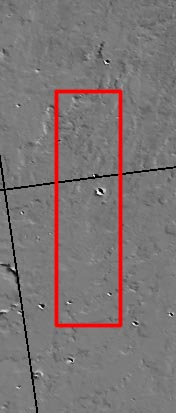
Released August 16, 2004
The THEMIS Image of the Day will be exploring the nomenclature of Mars for the next three weeks.
Daedalia Planum
- Planum: plateau or high plain
- Daedalia: Daedalus was a famous inventor, architect, and craftsman. He designed the Labyrith at Knossos (the Minotaur's prison), and the wings that caused the death of his son, Icarus.
Daedalia Planum is located south of Arsia Mons. Topographically, this area appeares to be a relatively featureless plain (as can be seen in the MOLA context image to the right). However, the daytime IR image shows multiple lava flows and small craters. The descriptor "fluctus" may be a better term to use now that we have better images of this region.
Nomenclature Fact of the Day: Small craters on Mars are named for towns and villages from all over the world with populations less than 100,000.
Image information: IR instrument. Latitude -18.4, Longitude 231.9 East (128.1 West). 100 meter/pixel resolution.
Note: this THEMIS visual image has not been radiometrically nor geometrically calibrated for this preliminary release. An empirical correction has been performed to remove instrumental effects. A linear shift has been applied in the cross-track and down-track direction to approximate spacecraft and planetary motion. Fully calibrated and geometrically projected images will be released through the Planetary Data System in accordance with Project policies at a later time.
NASA's Jet Propulsion Laboratory manages the 2001 Mars Odyssey mission for NASA's Office of Space Science, Washington, D.C. The Thermal Emission Imaging System (THEMIS) was developed by Arizona State University, Tempe, in collaboration with Raytheon Santa Barbara Remote Sensing. The THEMIS investigation is led by Dr. Philip Christensen at Arizona State University. Lockheed Martin Astronautics, Denver, is the prime contractor for the Odyssey project, and developed and built the orbiter. Mission operations are conducted jointly from Lockheed Martin and from JPL, a division of the California Institute of Technology in Pasadena.

 Planetary Data System
Planetary Data System













